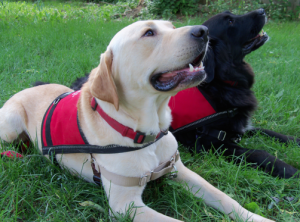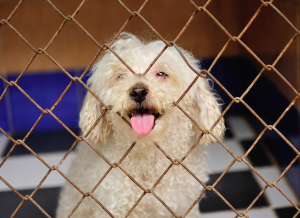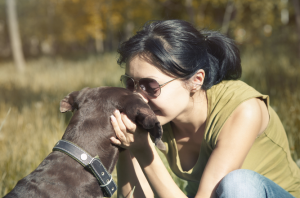 I train service dogs for a living. Where do I get my dogs? From the local shelters! 100% of the dogs that we train and place as service dogs come predominantly from the local Humane Societies and rescue groups and have been surrendered by their previous owner or found on the streets. Yet service dogs are held to the highest level of training and behavior. They’re confronted with many different situations and people on a daily basis and need to be confident and trustworthy even in the most extreme of situations. Toddlers may run up to the dogs, strangers may pet them as they walk by or make strange sounds to get their attention, the crowd might clap at the end of a movie or play, a person in a bunny or Santa costume may be walking around the mall. On and on, the dogs have to be able to adapt quickly, work and perform under any situation and most of all, be safe to take around the public. So why rely on shelter dogs? After all, we know little to nothing about their history? Why? Because I believe it’s the right thing to do and most of all, because there are plenty of great dogs in the shelter, even dogs that may one day save a life.
I train service dogs for a living. Where do I get my dogs? From the local shelters! 100% of the dogs that we train and place as service dogs come predominantly from the local Humane Societies and rescue groups and have been surrendered by their previous owner or found on the streets. Yet service dogs are held to the highest level of training and behavior. They’re confronted with many different situations and people on a daily basis and need to be confident and trustworthy even in the most extreme of situations. Toddlers may run up to the dogs, strangers may pet them as they walk by or make strange sounds to get their attention, the crowd might clap at the end of a movie or play, a person in a bunny or Santa costume may be walking around the mall. On and on, the dogs have to be able to adapt quickly, work and perform under any situation and most of all, be safe to take around the public. So why rely on shelter dogs? After all, we know little to nothing about their history? Why? Because I believe it’s the right thing to do and most of all, because there are plenty of great dogs in the shelter, even dogs that may one day save a life.
Only a small number of dogs have what it takes to be a service dog (from the shelter or the local breeder). But whether we need a working dog or a companion, when looking for a dog, adopting from a shelter can present a number of advantages over any other source.
There are true advantages to getting a dog from a shelter:
 We’re saving a life! If anything, choosing the adoption route is a rewarding experience. We’re offering a new lease on life to an animal that went through some hard times. We’re also supporting the efforts of the shelters in helping the animals in need.
We’re saving a life! If anything, choosing the adoption route is a rewarding experience. We’re offering a new lease on life to an animal that went through some hard times. We’re also supporting the efforts of the shelters in helping the animals in need.- Many shelter dogs are very affectionate and will quickly bond with their new owner. Most animals were surrendered due to a death, an illness, a new baby or a change in the life of their owner, not because there was anything intrinsically wrong with them. When they’ve been through the trauma of abandonment, they will often form very strong bonds with their new family. Even as adults, they often make very loving companions.
- Dogs in shelters come in all shapes, sizes, ages and breeds. So when visiting a shelter, there are many different types of dogs to choose from. If we’re attached to the idea of having a purebred dog or if we’re looking for a particular breed, we still have plenty of options purebred dogs are surrendered too. In fact, one in four dogs in shelters is a purebred dog. As I’m writing this blog I have a husky, a flat coated retriever, a border collie and two Labradors lying at my feet. They may not come with AKC documents, but the looks and the basic temperaments are there. Petfinder.com is a great resource when we’re looking for a specific type of dog and many rescue organizations specialize in certain breeds. When we’re open to a broader selection, shelters are also full of mixed dogs. Some will show visible traits of recognizable breeds. Others, the “pure mutts”, offer a variety of original and unique looks. What is more special than having a dog that looks like no other?
- In most shelters, the dogs have been evaluated for health issues. There are those dogs with health challenges that are waiting for a kind heart to care for them, but most dogs are healthy, fully vaccinated, spayed and neutered and checked for apparent medical concerns. Even after paying for the adoption fee, this is quite a savings over getting a dog from any other source, including from a free add in the paper.
- Many shelters run the dogs through a behavioral evaluation before putting them on the floor. The dogs are assessed for their friendliness with people and dogs; their reactions when approached while eating, their level of anxiety and fear, and of course for any potential risk that they might present. The dogs with major or concerning behavior issues are typically not put up for adoption. This also means that the staff can provide some valuable information about the dogs and help pick out the dog that seems the best fit.
- Shelters offer dogs of all ages, from puppies to seniors and everything in between. Everybody’s needs are a little different. If we’re well into retirement, it makes sense to look for an older pooch. They’re generally calmer and less demanding than the younger dogs. There are also plenty of puppies if that’s what we’re looking for, and if we’re willing to take on the work that comes with the responsibility. They’re cute and easy to fall in love with, but do we really want to go through the hassle of potty training, of cleaning up the messes, of crate training, etc? My preference is for the dogs in their late adolescence to young adult age. Most are house broken, crate trained and come with some basics of living in a house. Unlike puppies, what we see if what we get. A 1-2 year old dog is much more stab
 le in his/her temperament. Puppies still have to go through different stages of development. Most puppies are social and playful at 3 months old, but there is no way to predict the development of potentially problematic behaviors. During their adolescence, the dogs may develop fears, reactivity, OCD, aggression, etc. In my opinion, getting an older dog has many advantages that far outweigh the few short months of cuteness of a younger puppy.
le in his/her temperament. Puppies still have to go through different stages of development. Most puppies are social and playful at 3 months old, but there is no way to predict the development of potentially problematic behaviors. During their adolescence, the dogs may develop fears, reactivity, OCD, aggression, etc. In my opinion, getting an older dog has many advantages that far outweigh the few short months of cuteness of a younger puppy.
So how to pick the right dog?
- The first key is to know what type of dog we’re looking for even before we head to the shelter. This is equally important when choosing a dog from any source, including a neighbor, a breeder or a store (which I would personally stay away from as most come from puppy mills). An honest introspection about our lifestyle and our knowledge in caring and training a dog should guide us in our decision. After all, we are committing ourselves for the next 10-15 years! There is nothing wrong in asking the shelter staff for some help in finding the right companion.
- Look for the dogs that are friendly. Some dogs will come up to the front of their kennel to interact, while others will stay in the back. When you talk to them and put your hand up to the bars, they should be engaging with you and seeking your attention. A social and outgoing dog is less likely to have aggression issues than a fearful dog.
- Look at the kennel. A dirty kennel with feces and urine could be a sign that the dog is not fully potty trained (unless of course the dog has diarrhea). Shredded bedding or toys could reveal a tendency for destruction when under stress or bored.
- Stand a few feet away and watch how the dog reacts to different people (including children) and dogs walking by. Lunging and barking should be a concern and discussed with the staff.
- Once you have identified a few potential candidates, take them out, one at a time. Most shelters have a designated space for potential adopters to get to know the dogs. Set the dog free and wait. Don’t move or talk to the dog. Watch how long it takes for the dog to try to interact with you. Some dogs will run around and focus on their surroundings, while others will be more interested in the people. Keep in mind though that the dog might need to potty first depending on how long it was kenneled before you took him/her out. The best candidate will look for ways to get your attention and you affection.
- Ask the shelter staff about a potential behavior assessment and pay close attention to any resource guarding issues, especially when directed towards people. A dog growling at the food bowl may be more of a challenge than you want to deal with. If the dog was not evaluated, get the help of staff and check how he/she reacts around food, toys and rawhides
- Once you’re a little more familiar with the dog, try running your hand on his/her body, even gently restraining him/her a little. Is the dog wagging and relaxed no matter what you do or do you notice stiffness, attempts to get away or to get your hand off? Some dogs may need a little work when it comes to being touched all over, so this is not necessarily a deal breaker depending on the reaction. You might have to put in a little time working with the dog however. If you see any aggression or if you have young children at home this is not the right dog.
- Watch how the dog reacts to different sounds. Some dogs will cower and hide if there is a loud noise. Other dogs might direct their attention to any small sound in the environment such as traffic going by, people talking etc. Such dogs may have a harder time adapting to changes in the environment and present more anxiety related behavioral issues.
- Take the dog out for a walk. Watch how he/she reacts to other people and dogs walking by. Pulling or excited jumping towards others is fine but lunging and barking should raise concern and be discussed with the shelter staff.
- Be prepared to leave empty handed! You may have to return to the shelter a few times before picking a dog. The dream dog may not be there just yet.
 Once you have set your heart on a dog, it’s time to take him/her home. When dogs come out of the shelter, they can be overwhelmed by all the changes they have to face: a new person, a new home, new habits, a new potty place, etc. So many dogs are a little inhibited and most will only show their true colors after 3-4 weeks of staying with you. It’s therefore important to check with the shelter staff that you can take the dog back within 30 days. The dog may not eat well for the first few days, but should quickly recover a healthy appetite. Treat the dog like a puppy at first and keep a close eye on any potential chewing and take him/her out to potty more often than normal. Most of all, just like with any other dog, be prepared to teach him/her good manners. It doesn’t matter how old the dog is, they can all learn new habits to better fit into your lifestyle. Unless you’re already a dog trainer, planning on attending a training class should be on your ‘must do’ list and will help you get on a good start with your new companion. Many shelters today offer such classes or will be able to refer you to a trainer.
Once you have set your heart on a dog, it’s time to take him/her home. When dogs come out of the shelter, they can be overwhelmed by all the changes they have to face: a new person, a new home, new habits, a new potty place, etc. So many dogs are a little inhibited and most will only show their true colors after 3-4 weeks of staying with you. It’s therefore important to check with the shelter staff that you can take the dog back within 30 days. The dog may not eat well for the first few days, but should quickly recover a healthy appetite. Treat the dog like a puppy at first and keep a close eye on any potential chewing and take him/her out to potty more often than normal. Most of all, just like with any other dog, be prepared to teach him/her good manners. It doesn’t matter how old the dog is, they can all learn new habits to better fit into your lifestyle. Unless you’re already a dog trainer, planning on attending a training class should be on your ‘must do’ list and will help you get on a good start with your new companion. Many shelters today offer such classes or will be able to refer you to a trainer.
Adopting a dog from a shelter is a rewarding experience. Even when they show signs of abuse or neglect, these dogs are still loving, affectionate and are deserving of a good life. Watching a dog slowly come out of his/her shell and turn into a well-adjusted and well-trained happy dog is both touching and fulfilling. That doesn’t happen magically however; just like getting a dog from any other source, you have to provide all that the dog needs. An honest look at how much we can do versus how much the dog needs is critical for a positive experience for all.
Happy adoption!
Jennifer Cattet Ph.D.


Excellent tips! I have adopted all of my animals and never once regretted it. Adopting and training service dogs is my absolute dream that I hope one day to accomplish, thank you for all of the good you are doing for both the dogs and people alike!
http://blog.smartanimaltraining.com/
fantastic tips getting a great dog from the shelter. thanks for share..
Thanks for all the reviews. We appreciate service dogs and are processing $10,000 LTM Service Grants for those who need dogs or those who train service dogs. Please join our investment groups at: http://www.meetup.com/SMART1/